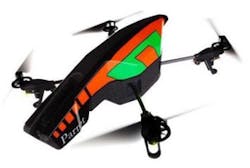UK researchers to model vision and smell of bees
Sussex University (Brighton, UK) scientists are working with partners at the Sheffield University (Sheffield, UK) to produce the first accurate computer models of a honey bee brain in a bid to advance their understanding of Artificial Intelligence.
The team will build models of the systems in the brain that govern honey bee vision and sense of smell.
Using this information, the researchers aim to create an autonomous flying robot, comprising an off-the-shelf flying robot and a bee-like “brain” in the form of a computer program. Instead of flying around via a remote control held by a human, the robot would be able to sense and act as autonomously as a bee.
If successful, the project will meet one of the major challenges of modern science: building a robot brain that can perform complex tasks as well as the brain of an animal.
Tasks the robot will be expected to perform, for example, will include finding the source of particular odors or gases in the same way that a bee can identify particular flowers.
Called "Green Brain", and partially supported with hardware donated by NVIDIA, the project is funded by the Engineering and Physical Sciences Research Council.
"The development of an artificial brain is one of the greatest challenges in artificial intelligence. So far, researchers have typically studied brains such as those of rats, monkeys, and humans, but actually 'simpler' organisms such as social insects have surprisingly advanced cognitive abilities," says Dr. James Marshall, who is leading the £1m project at Sheffield University.
Recent articles on artificial intelligence from Vision Systems Design that you might also find of interest.
1. Smarter software helps military surveillance
Ground surveillance is a task normally performed by soldiers, but military leaders would like to shift the task to unmanned systems, removing troops from harm's way.
2. Brain power boosts recognition rate of image analysis system
Researchers at DARPA have demonstrated the effectiveness of a system that couples cameras, computers and input from an operator's brainwaves to detect threats to soldiers in the field.
3. Smart software secures surveillance systems
Engineers at Behavioral Recognition Systems (BRS; Houston, TX, USA) have developed video surveillance recognition software that can learn to identify abnormal behavior of individuals in CCTV video footage.
-- Dave Wilson, Senior Editor, Vision Systems Design
